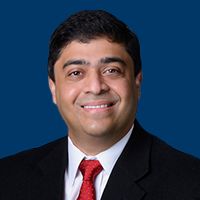Video
Key Members of the Multidisciplinary Team
Transcript:Brian A. Van Tine, MD, PhD: I think that was actually a really good lead-off, and I just want to have a brief discussion of this next topic. Everybody says “multidisciplinary care” and I think the assumption is that you have a medical oncologist in the room with a surgeon, a pathologist, and a radiologist. But I think that the multidisciplinary team is actually much, much bigger than that.
So, I wanted to get your thoughts of what people aren’t thinking of when we are talking about multidisciplinary care because, outside of breast cancer, the number-one identifier of genetic syndrome families usually gets initiated by us. The patients really from the beginning that we’re with, the patients with retinoblastoma, we’re following these patients. So, what else is in your unique multidisciplinary teams that people aren’t thinking of, which is really the importance of these centers?
Andrew J. Wagner, MD, PhD: Well, I would say for us, one of the most important things is our social worker team.
R. Lor Randall, MD, FACS: I was going to say the exact same thing.
Andrew J. Wagner, MD, PhD: We have a lot of young patients. Sarcomas affect people of all ages. It’s not a typical carcinoma presentation of someone in their 60s and 70s. These are tumors that, in adult oncology, we see people in their teens and 20s and 30s with this. They’re people transitioning into adulthood who are struggling with that and, with their cancer and transitioning into adulthood—struggling with that—and the dynamics between those young adults and their parents.
We have patients who are young parents who have young kids and the issues with what’s happening with their children. It is heart-wrenching obviously, but the adolescent/young adult programs at many of our centers have the involvement of social workers who are familiar, not just with cancer, but with dealing with young adults with cancer, is really important.
Brian A. Van Tine, MD, PhD: And don’t forget about the reproductive endocrinologists because that’s complex, especially when you have a Ewing’s sarcoma patient and need to move fast. I mean, there are so many other members that are unsung heroes that when you really walk into these multidisciplinary centers, I think everybody’s surgery and radiation and medical oncology, the depth of really what’s there. Is there anything unique in London?
Robin L. Jones, MD, MRCP: I think just to echo what Andy said basically, that there are other people, not only physicians, not only gastroenterologists, interventional radiologists, but social workers, specialists, nurses, as well, do such a fantastic job in terms of helping all of these people going through very, very difficult treatment and dealing with a very difficult diagnosis. So, it’s definitely bigger than just the physicians. It’s a full team of very caring and very experienced professional staff.
Shreyaskumar R. Patel, MD: In more recent years, we have actually integrated a geneticist and a physical therapist in our clinics. And, as Lor will attest to, I think from a functional standpoint, functional assessments, improving functional outcomes and stuff, I think their early involvement becomes very critical.
As we learn more about the genetic makeup of their diseases—and plenty of sarcomas are part of genetic syndromes and multiple cancer syndromes—I think having the geneticist has been very helpful. And again, we haven’t mentioned it so I will put it out there.
The unsung heroes of the multidisciplinary team treating these patients happen to be the nurses, the midlevel providers, and the pharmacists, right? So, I think integrating them into the team so they feel like part of the team, even throughout the decision making and distributing the treatment, for example, I think it becomes very important.
Robin L. Jones, MD, MRCP: It is interesting, at our meeting, the superintendent of the radiology department comes to the meetings, so if we need to do a scan quickly for a new patient, she can
then just get that organized after the meeting. And just to show that it’s much, much bigger than just the physician.
Transcript Edited for Clarity









